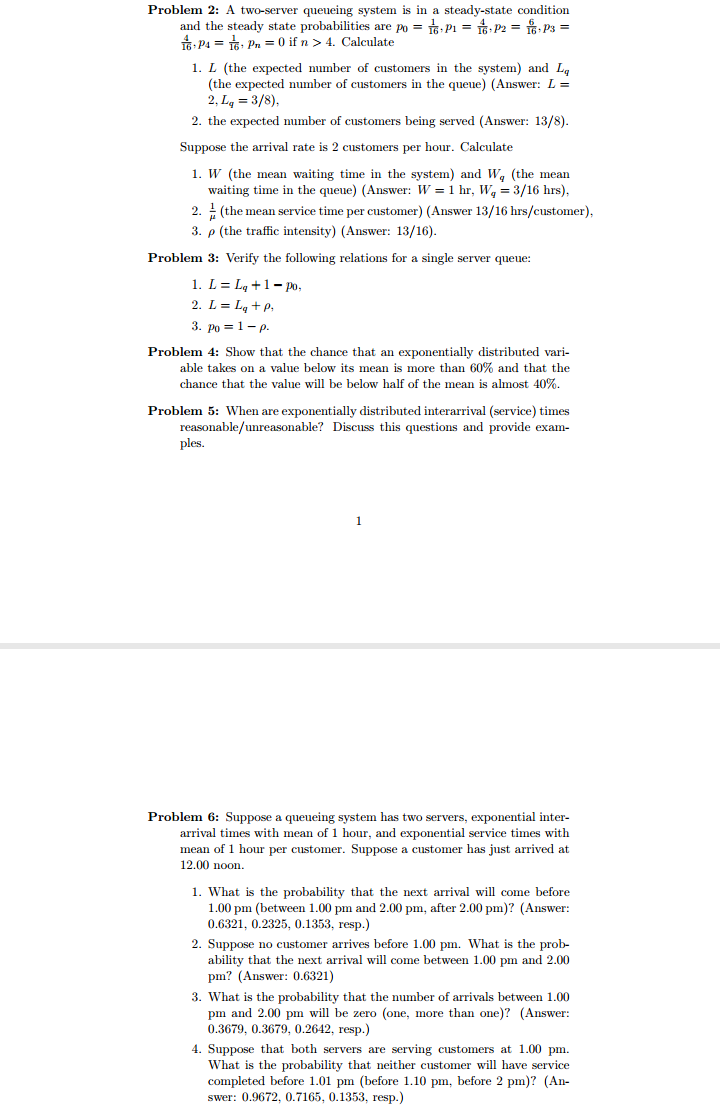
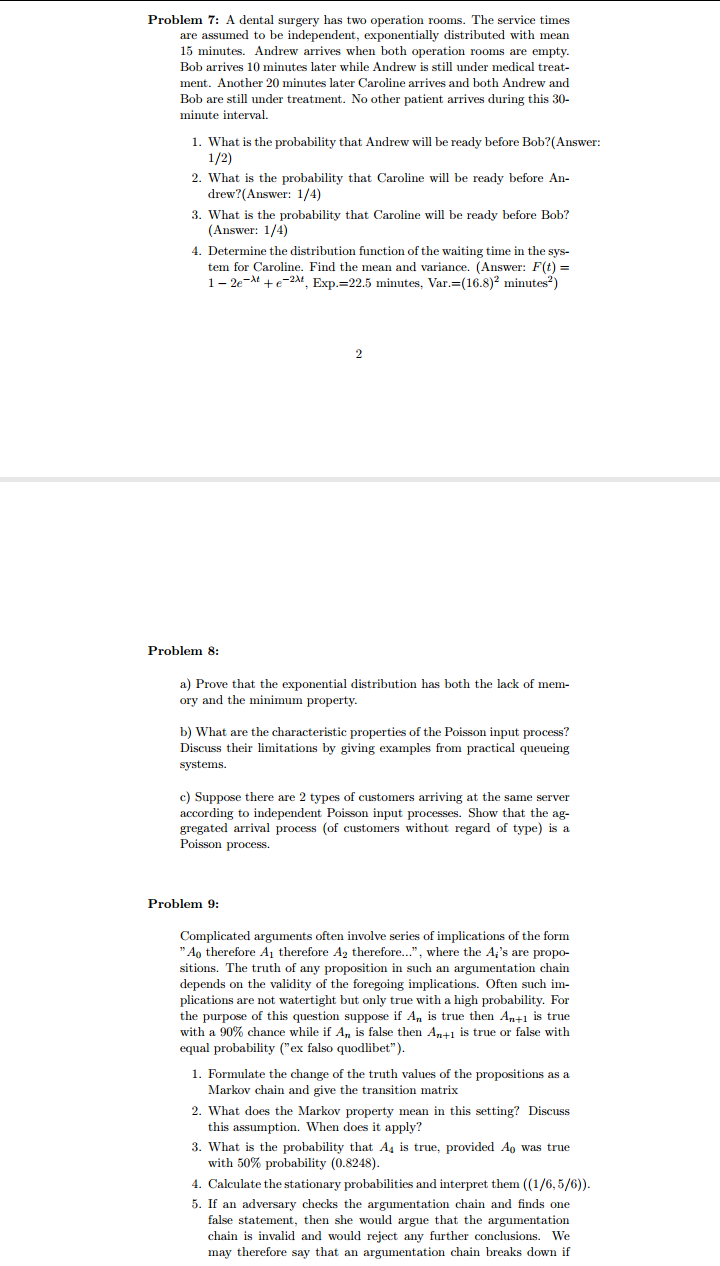
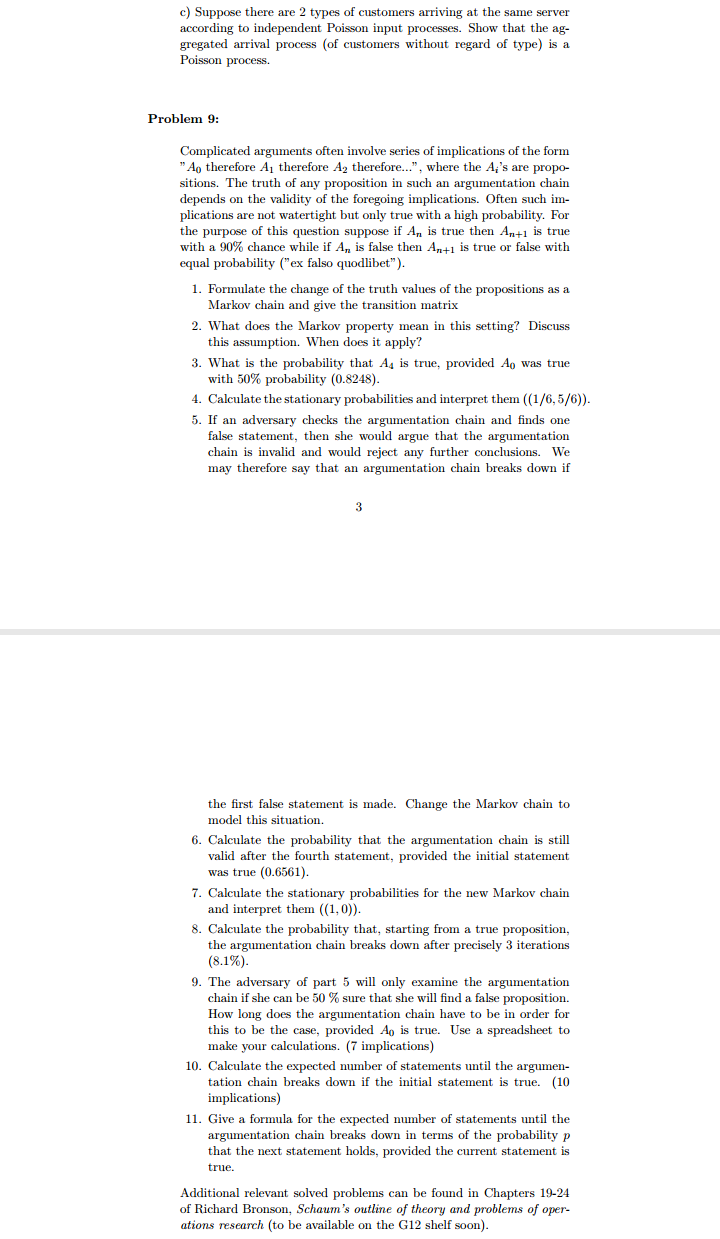
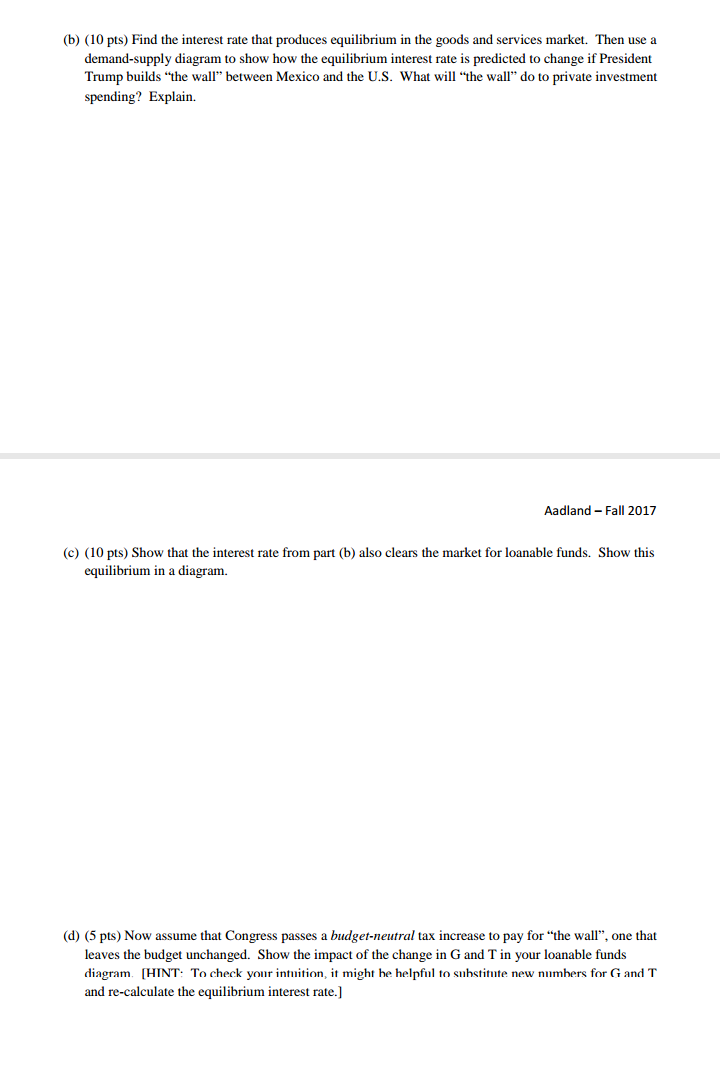
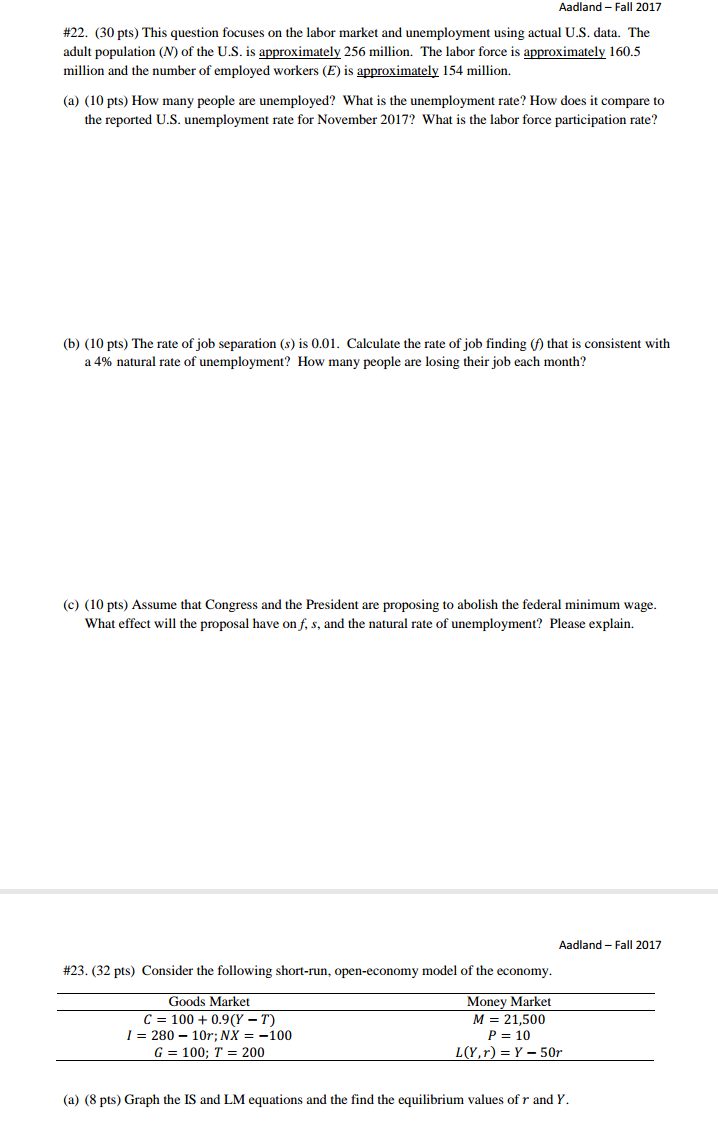
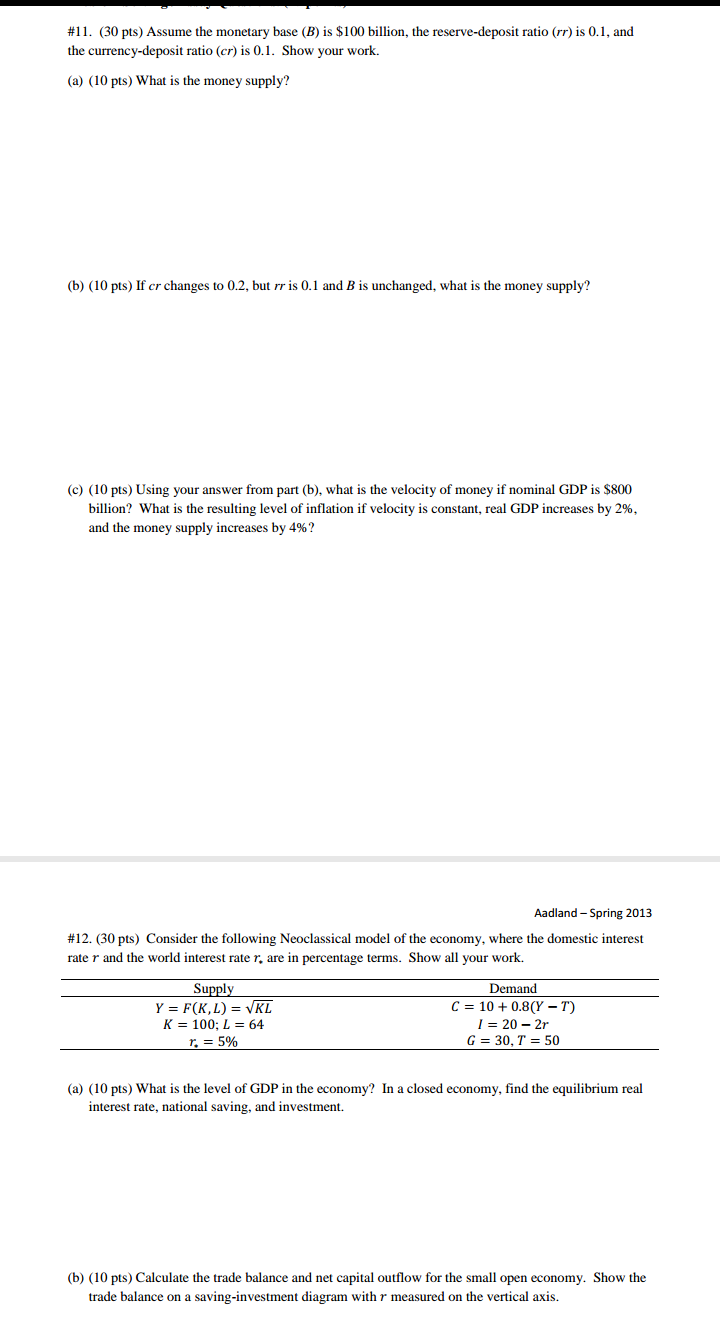
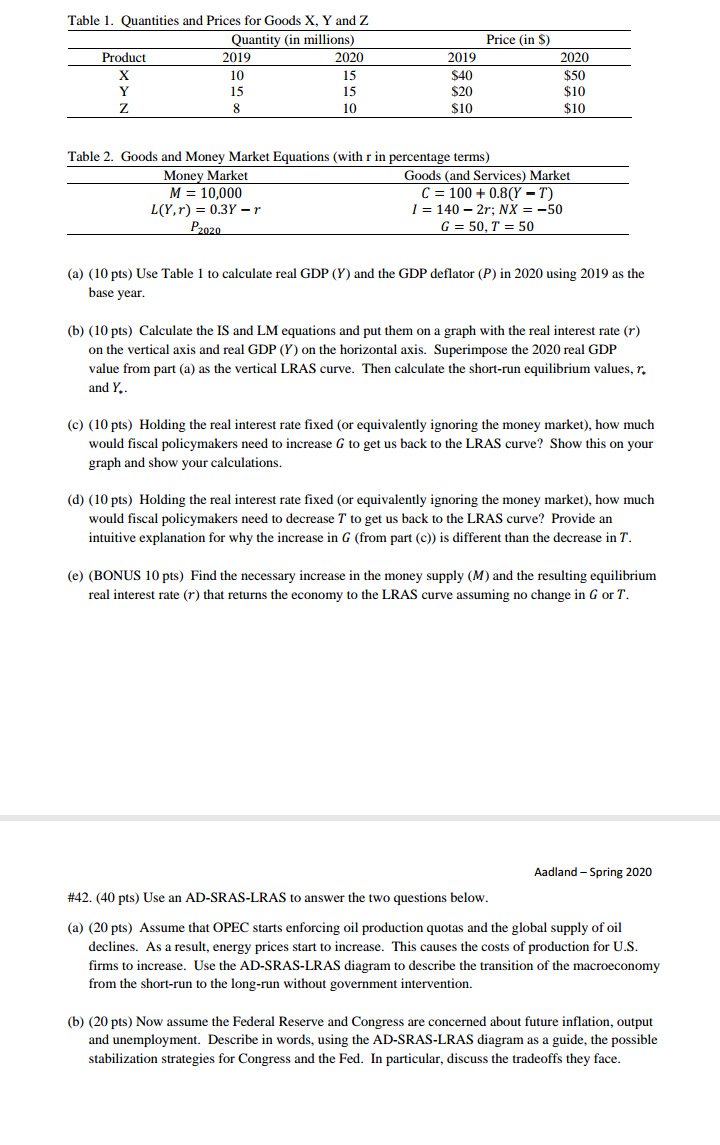
Please help me with my macro quiz
Problem 2: A two-server queueing system is in a steady-state condition and the steady state probabilities are po = 16: P1 = 16 : P2 = 16:P3 = 16 . PA = 16: Pn = 0 if n > 4. Calculate 1. L (the expected number of customers in the system) and Lo (the expected number of customers in the queue) (Answer: L = 2, Lq = 3/8). 2. the expected number of customers being served (Answer: 13/8). Suppose the arrival rate is 2 customers per hour. Calculate 1. W (the mean waiting time in the system) and W, (the mean waiting time in the queue) (Answer: W = 1 hr, W, = 3/16 hrs). 2. - (the mean service time per customer) (Answer 13/16 hrs/customer), 3. p (the traffic intensity) (Answer: 13/16). Problem 3: Verify the following relations for a single server queue: 1. L = Lq + 1 - po, 2. L = Lq + P. 3. po = 1 - p. Problem 4: Show that the chance that an exponentially distributed vari- able takes on a value below its mean is more than 60% and that the chance that the value will be below half of the mean is almost 40%. Problem 5: When are exponentially distributed interarrival (service) times reasonable/unreasonable? Discuss this questions and provide exam- ples. Problem 6: Suppose a queueing system has two servers, exponential inter- arrival times with mean of 1 hour, and exponential service times with mean of 1 hour per customer. Suppose a customer has just arrived at 12.00 noon. 1. What is the probability that the next arrival will come before 1.00 pm (between 1.00 pm and 2.00 pm, after 2.00 pm)? (Answer: 0.6321, 0.2325, 0.1353, resp.) 2. Suppose no customer arrives before 1.00 pm. What is the prob- ability that the next arrival will come between 1.00 pm and 2.00 pm? (Answer: 0.6321) 3. What is the probability that the number of arrivals between 1.00 pm and 2.00 pm will be zero (one, more than one)? (Answer: 0.3679, 0.3679, 0.2642, resp.) 4. Suppose that both servers are serving customers at 1.00 pm. What is the probability that neither customer will have service completed before 1.01 pm (before 1.10 pm, before 2 pm)? (An- swer: 0.9672, 0.7165, 0.1353, resp.)Problem 7: A dental surgery has two operation rooms. The service times are assumed to be independent, exponentially distributed with mean 15 minutes. Andrew arrives when both operation rooms are empty. Bob arrives 10 minutes later while Andrew is still under medical treat- ment. Another 20 minutes later Caroline arrives and both Andrew and Bob are still under treatment. No other patient arrives during this 30- minute interval. 1. What is the probability that Andrew will be ready before Bob?(Answer: 1/2) 2. What is the probability that Caroline will be ready before An- drew?(Answer: 1/4) 3. What is the probability that Caroline will be ready before Bob? (Answer: 1/4) 4. Determine the distribution function of the waiting time in the sys- tem for Caroline. Find the mean and variance. (Answer: F(t) = 1 - 2e-At + e-2At, Exp.=22.5 minutes, Var.=(16.8) minutes") 2 Problem 8: a) Prove that the exponential distribution has both the lack of mem- ory and the minimum property. b) What are the characteristic properties of the Poisson input process? Discuss their limitations by giving examples from practical queueing systems. c) Suppose there are 2 types of customers arriving at the same server according to independent Poisson input processes. Show that the ag- gregated arrival process (of customers without regard of type) is a Poisson process. Problem 9: Complicated arguments often involve series of implications of the form "Ao therefore Aj therefore A2 therefore...", where the A,'s are propo- sitions. The truth of any proposition in such an argumentation chain depends on the validity of the foregoing implications. Often such im- plications are not watertight but only true with a high probability. For the purpose of this question suppose if An is true then Anti is true with a 90% chance while if A, is false then Anti is true or false with equal probability ("ex falso quodlibet"). 1. Formulate the change of the truth values of the propositions as a Markov chain and give the transition matrix 2. What does the Markov property mean in this setting? Discuss this assumption. When does it apply? 3. What is the probability that As is true, provided Ao was true with 50% probability (0.8248). 4. Calculate the stationary probabilities and interpret them ((1/6, 5/6)). 5. If an adversary checks the argumentation chain and finds one false statement, then she would argue that the argumentation chain is invalid and would reject any further conclusions. We may therefore say that an argumentation chain breaks down ifc) Suppose there are 2 types of customers arriving at the same server according to independent Poisson input processes. Show that the ag- gregated arrival process (of customers without regard of type) is a Poisson process. Problem 9: Complicated arguments often involve series of implications of the form 'Ao therefore Aj therefore A2 therefore..", where the A;'s are propo- sitions. The truth of any proposition in such an argumentation chain depends on the validity of the foregoing implications. Often such im- plications are not watertight but only true with a high probability. For the purpose of this question suppose if An is true then Anti is true with a 90% chance while if An is false then Anti is true or false with equal probability ("ex falso quodlibet"). 1. Formulate the change of the truth values of the propositions as a Markov chain and give the transition matrix 2. What does the Markov property mean in this setting? Discuss this assumption. When does it apply? 3. What is the probability that As is true, provided Ao was true with 50% probability (0.8248). 4. Calculate the stationary probabilities and interpret them ((1/6,5/6)). 5. If an adversary checks the argumentation chain and finds one false statement, then she would argue that the argumentation chain is invalid and would reject any further conclusions. We may therefore say that an argumentation chain breaks down if 3 the first false statement is made. Change the Markov chain to model this situation. 6. Calculate the probability that the argumentation chain is still valid after the fourth statement, provided the initial statement was true (0.6561). 7. Calculate the stationary probabilities for the new Markov chain and interpret them ((1, 0)). 8. Calculate the probability that, starting from a true proposition, the argumentation chain breaks down after precisely 3 iterations (8.1%) 9. The adversary of part 5 will only examine the argumentation chain if she can be 50 % sure that she will find a false proposition. How long does the argumentation chain have to be in order for this to be the case, provided An is true. Use a spreadsheet to make your calculations. (7 implications) 10. Calculate the expected number of statements until the argumen- tation chain breaks down if the initial statement is true. (10 implications) 11. Give a formula for the expected number of statements until the argumentation chain breaks down in terms of the probability p that the next statement holds, provided the current statement is true. Additional relevant solved problems can be found in Chapters 19-24 of Richard Bronson, Schaum's outline of theory and problems of oper- ations research (to be available on the G12 shelf soon).(b) (10 pts) Find the interest rate that produces equilibrium in the goods and services market. Then use a demand-supply diagram to show how the equilibrium interest rate is predicted to change if President Trump builds "the wall" between Mexico and the U.S. What will "the wall" do to private investment spending? Explain. Aadland - Fall 2017 (c) (10 pts) Show that the interest rate from part (b) also clears the market for loanable funds. Show this equilibrium in a diagram. (d) (5 pts) Now assume that Congress passes a budget-neutral tax increase to pay for "the wall", one that leaves the budget unchanged. Show the impact of the change in G and T in your loanable funds diagram. [HINT: To check your intuition, it might be helpful to substitute new numbers for G and T and re-calculate the equilibrium interest rate.]Aadland - Fall 2017 #22. (30 pts) This question focuses on the labor market and unemployment using actual U.S. data. The adult population (N) of the U.S. is approximately 256 million. The labor force is approximately 160.5 million and the number of employed workers (E) is approximately 154 million. (a) (10 pts) How many people are unemployed? What is the unemployment rate? How does it compare to the reported U.S. unemployment rate for November 2017? What is the labor force participation rate? (b) (10 pts) The rate of job separation (s) is 0.01. Calculate the rate of job finding (f) that is consistent with a 4% natural rate of unemployment? How many people are losing their job each month? (c) (10 pts) Assume that Congress and the President are proposing to abolish the federal minimum wage. What effect will the proposal have on f, s, and the natural rate of unemployment? Please explain. Aadland - Fall 2017 #23. (32 pts) Consider the following short-run, open-economy model of the economy. Goods Market Money Market C = 100 + 0.9(Y - T) M = 21,500 1 = 280 - 10r; NX = -100 P = 10 G = 100; T = 200 L(Y, r) = Y - 50r (a) (8 pts) Graph the IS and LM equations and the find the equilibrium values of r and Y.#11. (30 pts) Assume the monetary base (B) is $100 billion, the reserve-deposit ratio (rr) is 0.1, and the currency-deposit ratio (cr) is 0.1. Show your work. (a) (10 pts) What is the money supply? (b) (10 pts) If er changes to 0.2, but or is 0.1 and B is unchanged, what is the money supply? (c) (10 pts) Using your answer from part (b), what is the velocity of money if nominal GDP is $800 billion? What is the resulting level of inflation if velocity is constant, real GDP increases by 2%, and the money supply increases by 4%? Aadland - Spring 2013 #12. (30 pts) Consider the following Neoclassical model of the economy, where the domestic interest rate r and the world interest rate r. are in percentage terms. Show all your work. Supply Demand Y = F(K, L) = VKL C = 10 + 0.8(Y - T) K = 100; L = 64 I = 20 - 2r r. = 5% G = 30, T = 50 (a) (10 pts) What is the level of GDP in the economy? In a closed economy, find the equilibrium real interest rate, national saving, and investment. (b) (10 pts) Calculate the trade balance and net capital outflow for the small open economy. Show the trade balance on a saving-investment diagram with r measured on the vertical axis.Table 1. Quantities and Prices for Goods X, Y and Z Quantity (in millions) Price (in $) Product 2019 2020 2019 2020 X 10 15 $40 $50 15 15 $20 $10 N - 8 10 $10 $10 Table 2. Goods and Money Market Equations (with r in percentage terms) Money Market Goods (and Services) Market M = 10,000 C = 100 + 0.8(Y - T) L(Y, r) = 0.3Y - r I = 140 - 2r; NX = -50 P20zo G = 50, T = 50 (a) (10 pts) Use Table 1 to calculate real GDP (Y) and the GDP deflator (P) in 2020 using 2019 as the base year. (b) (10 pts) Calculate the IS and LM equations and put them on a graph with the real interest rate (r) on the vertical axis and real GDP (Y) on the horizontal axis. Superimpose the 2020 real GDP value from part (a) as the vertical LRAS curve. Then calculate the short-run equilibrium values, r. and Y.. (c) (10 pts) Holding the real interest rate fixed (or equivalently ignoring the money market), how much would fiscal policymakers need to increase G to get us back to the LRAS curve? Show this on your graph and show your calculations. (d) (10 pts) Holding the real interest rate fixed (or equivalently ignoring the money market), how much would fiscal policymakers need to decrease T to get us back to the LRAS curve? Provide an intuitive explanation for why the increase in G (from part (c)) is different than the decrease in T. (e) (BONUS 10 pts) Find the necessary increase in the money supply (M) and the resulting equilibrium real interest rate (r) that returns the economy to the LRAS curve assuming no change in G or T. Aadland - Spring 2020 #42. (40 pts) Use an AD-SRAS-LRAS to answer the two questions below. (a) (20 pts) Assume that OPEC starts enforcing oil production quotas and the global supply of oil declines. As a result, energy prices start to increase. This causes the costs of production for U.S. firms to increase. Use the AD-SRAS-LRAS diagram to describe the transition of the macroeconomy from the short-run to the long-run without government intervention. (b) (20 pts) Now assume the Federal Reserve and Congress are concerned about future inflation, output and unemployment. Describe in words, using the AD-SRAS-LRAS diagram as a guide, the possible stabilization strategies for Congress and the Fed. In particular, discuss the tradeoffs they face




















